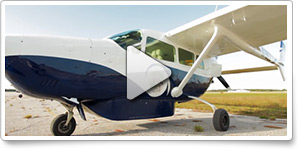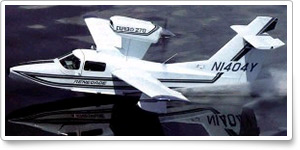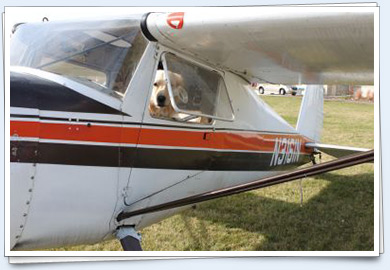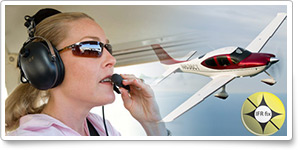| ||||||
| ABLE FLIGHT TO TRAIN WOUNDED MARINE |
| |||||
| Sponsored by: | ||||||
Training TipsWinter nights Now is the time of year to nail down those requirements for the private pilot certificate. Under the regulations you must have three hours of night flight training in a single-engine airplane that includes one cross-country flight of more than 100 nautical miles total distance, and "10 takeoffs and 10 landings to a full stop (with each landing involving a flight in the traffic pattern) at an airport" to be eligible for night-flying privileges. The Air Safety Institute’s Night Flying Safety Spotlight will help you to review some special considerations for planning and executing a night flight. Three hours will give you a taste of night flight, but hardly a complete survey. So it’s not automatically a good idea to log all the required night training in one long evening session. Dividing it into multiple missions broadens your experience, and avoids fatigue. Launching on the initial night flight at dusk and continuing under moonlight is an ideal introduction. Next time, move on to darker skies and more challenging surface winds. This lesson plan offers night-flight preparation pointers. As for that 100-nm cross-country flight: Select a route by giving possible destinations careful review. Note what kind of lighting exists at planned stops. Research how to operate any pilot-controlled lighting system. If you selected a towered airport, check hours of tower operation. If the tower is closed when you arrive, what airspace class will be in effect? Build a strong margin of obstacle clearance into your selection of a cruise altitude, with forecast cloud levels also to be considered. Keep night fuel-reserve requirements in mind when calculating your requirements. Will you overfly or pass near other airports en route? That's good insurance in the event of an emergency. Expect to rely much more on your attitude-control instruments under night VFR conditions. Keep a running check on weather—ahead and behind—paying attention to any narrowing temperature/dew-point spread. That spread is your early warning about formation of fog. Certain optical illusions are characteristic of night flight. Also, crosswinds may seem more pronounced with fewer visual references by which to judge their intensity. Practicing those 10 (or more) takeoffs and landings will be exhilarating—and light traffic may give you more options. Your instructor may have you land once or twice without your landing light—good experience, and landing lights do sometimes fail. Enjoy the beauty of night flight, while moving your training forward.
Flight Training NewsAble Flight to train wounded MarineAdam Kisielewski came home from Iraq in 2005 minus his left arm and his right leg below the knee. With the help of his fighting spirit and the wonders of modern battlefield medicine, he is moving on to a longtime goal. He will soon begin pursuing the dream of flight thanks to a training scholarship provided by Able Flight, an organization that seeks to help people with disabilities. Kisielewski lives in Frederick, Md., and flew with AOPA Pilot Senior Editor Dave Hirschman in the 2012 Tougher than a Tornado Sweepstakes Husky. Liberty University dismantling helicopter programLiberty University in Lynchburg, Va., will disband its helicopter flight training program this year, just four years after the program was launched. Officials cited low student interest and limited job opportunities for helicopter pilots. Meanwhile, the university will expand its program on unmanned aircraft systems, according to a report in the Lynchburg News & Advance. Liberty's school of aeronautics reports more than 600 enrollees.
How well do you know aircraft engines?Compared to the ultra-refined, practically maintenance-free engines in cars these days, most aircraft powerplants are serious attention hogs. From tricky hot- and cold-start procedures to the vagaries of cruise power settings, leaning, and temperature management, there's just a lot more to think about. Are you an expert on aircraft engine operations? Test yourself with this week's Air Safety Institute safety quiz. Santa Monica flight schools to limit nighttime takeoffs and landingsThe six flight schools that operate at Santa Monica Municipal Airport in Santa Monica, Calif., volunteered to reduce the number of nighttime takeoffs and landings. The schools have been the target of many complaints from neighborhood groups. In December, the flight schools said renters and instructors will not make repeated takeoffs and landings after 8 p.m. Monday through Saturday until March. Repeated takeoffs and landings would cease after 8 p.m. on Sundays throughout the year, according to SantaMonicaPatch.com.
Training ResourcesBecoming a pilot means more than knowing how to control the aircraft after the wheels leave the ground. Nearly every flight begins and ends on a runway, and understanding how to navigate to that runway safely is an essential skill for every pilot to master. Take the Runway Safety online course from the Air Safety Institute and learn more about avoiding runway incursions as well as tips for making the transition from the ramp to the air a little easier.
Did you know that student pilots who join AOPA are three times more likely to complete their flight training? Membership includes unlimited access to aviation information by phone (800/USA-AOPA, weekdays from 8:30 a.m. to 6 p.m. Eastern time) or from Flight Training Online or AOPA Online. If you're not already a member, join today and get the pilot’s edge. Login information is available online.
Mission pilot’s airplane gets an ‘Extreme Makeover’ Career Pilot | ||||||||||||||||||||||||||||||||||||||||||||||||||
| | Bose® A20® Aviation Headset The best we’ve ever made |
AOPA Career Opportunities
Ever dream of turning your passion for aviation into a career? We’re looking for a corporate partnership coordinator, chief flight instructor, director of corporate finance, manager of flight training programs, AOPA Live producer/videojournalist, associate editor–Web/ ePilot, and aviation technical specialist. To learn more about other AOPA career opportunities, visit AOPA Online.
Community
| |||||
AVIATION EVENTS & WEATHER
| To include an event or to search all events in the calendar, visit AOPA Online. For airport details, including FBO fuel prices, see AOPA Airports. | ||||||||||||||||
Final ExamQuestion: How soon after passing the practical test for the private pilot certificate may I exercise the privileges of that certificate?
Answer: You may do so immediately. After you pass the practical test, the designated pilot examiner will issue you a temporary airman certificate. This certificate allows you to exercise the privileges of your private pilot certificate with the appropriate ratings and/or limitations. The temporary certificate is an interim one, subject to the approval of the FAA pending the issuance of your permanent certificate. You should receive your permanent certificate within 120 days.
Got a question for our technical services staff? Email [email protected] or call the Pilot Information Center, 800/872-2672. Don’t forget the online archive of “Final Exam” questions and answers, searchable by keyword or topic.
Instrument Tip | ||||||||||||||||
Flight Instructor Refresher Clinics | Air Safety Institute Safety Seminars | |||||||||
For a complete schedule, see AOPA Online. Can’t make it in person? Sign up for the CFI Refresher Online. |
Topics vary—for details and a complete schedule, see AOPA Online. | |||||||||
| | ||||
| ePilot Flight Training Editor: ePilot Editor: | Contributors: Alyssa Miller | | Production Team: Melissa Whitehouse Siobhan Byrne Lezlie Ramsey William Rockenbaugh Mitch Mitchell | Advertise in ePilot: |
| Member Tools: Send feedback | ePilot Archive Got news or questions? Contact ePilot. Having difficulty using this service? Visit the ePilot Frequently Asked Questions at AOPA Online or email us. | ||||




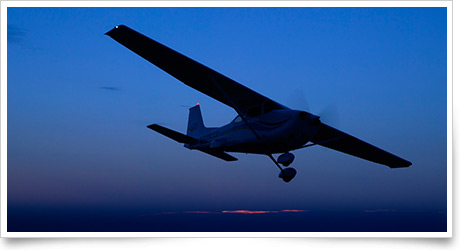 Got your night flying done yet?
Got your night flying done yet?